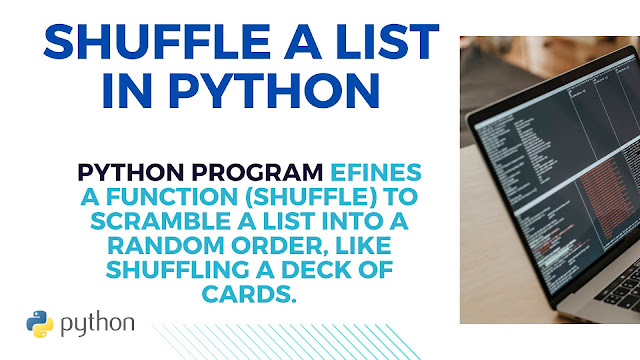Are you looking to shuffle a list in Python? Whether you're working on a card game or just need to randomize a list, shuffling a list is a common task in programming.
In this blog post, we'll walk you through how to write a program that defines a function to shuffle a list into a random order, like shuffling a deck of cards.
Table of Contents:- Problem Statement
- What is shuffling a list?
- How to shuffle a list in Python
Problem Statement: Python Program to Shuffle Deck of Cards
Write a program that defines a function (shuffle) to scramble a list into a random order, like shuffling a deck of cards.What is shuffling a list?
Shuffling a list means to randomize the order of the elements in the list. This is often used in card games, where the order of the cards in the deck needs to be randomized before dealing.
How to shuffle a list in Python
Python has a built-in function called shuffle() that can be used to shuffle a list. Here's an example of how to use it:
import random
my_list = [1, 2, 3, 4, 5]
random.shuffle(my_list)
print(my_list)
This will output a shuffled version of the list, like [3][1][5][4][2].
If you want to define your own function to shuffle a list, you can do so like this:
import random
def shuffle_list(lst):
random.shuffle(lst)
return lst
This function takes a list as an argument, shuffles it using the shuffle() function, and then returns the shuffled list.
| Practical List - Python Tutorial [ 4330701 ] [ PRACTICAL EXERCISES ]
What is shuffling a deck of cards?
Shuffling a deck of cards means to randomize the order of the cards in the deck. This is often used in card games, where the order of the cards in the deck needs to be randomized before dealing.
How to shuffle a deck of cards in Python
To shuffle a deck of cards in Python, we can use a combination of lists, loops, and functions. Here's an example of how to shuffle a deck of cards:
import random
suits = ['hearts', 'diamonds', 'clubs', 'spades']
values = ['ace', '2', '3', '4', '5', '6', '7', '8', '9', '10', 'jack', 'queen', 'king']
deck = []
for suit in suits:
for value in values:
card = value + ' of ' + suit
deck.append(card)
def shuffle_deck(deck):
random.shuffle(deck)
return deck
shuffled_deck = shuffle_deck(deck)
print(shuffled_deck)
This will output a shuffled version of the deck of cards, like ['king of diamonds', '8 of hearts', 'ace of spades', ...]. The shuffle_deck() function shuffles the deck using the shuffle() function from the random module.
Shuffling a list in Python is a simple task that can be accomplished using the built-in shuffle() function.
If you need to define your own function to shuffle a list, you can do so using the shuffle() function and returning the shuffled list. With these tools, you'll be able to easily shuffle lists in Python.
FAQs: Python Program to Shuffle Deck of Cards
What is the purpose of shuffling a deck of cards in Python programming?
Shuffling a deck of cards in Python programming is done to randomize the order of the cards in the deck. The purpose of shuffling is to introduce an element of chance and ensure fairness in card games. By shuffling the deck, the order of the cards becomes unpredictable, creating a more exciting and unpredictable gameplay experience. Shuffling a deck of cards in Python can be achieved using the shuffle() function from the random module. This function rearranges the elements of a list in a random order. By applying the shuffle() function to a list representing a deck of cards, we can achieve a randomized deck. Shuffling a deck of cards is often followed by a cut, which further ensures that the shuffler has not manipulated the outcome. The combination of shuffling and cutting the deck helps to maintain fairness and integrity in card games.
%20to%20scramble%20a%20list%20into%20a%20random%20order,%20like%20shuffling%20a%20deck%20of%20cards.%20%20%20%20.jpg)



0 Comments